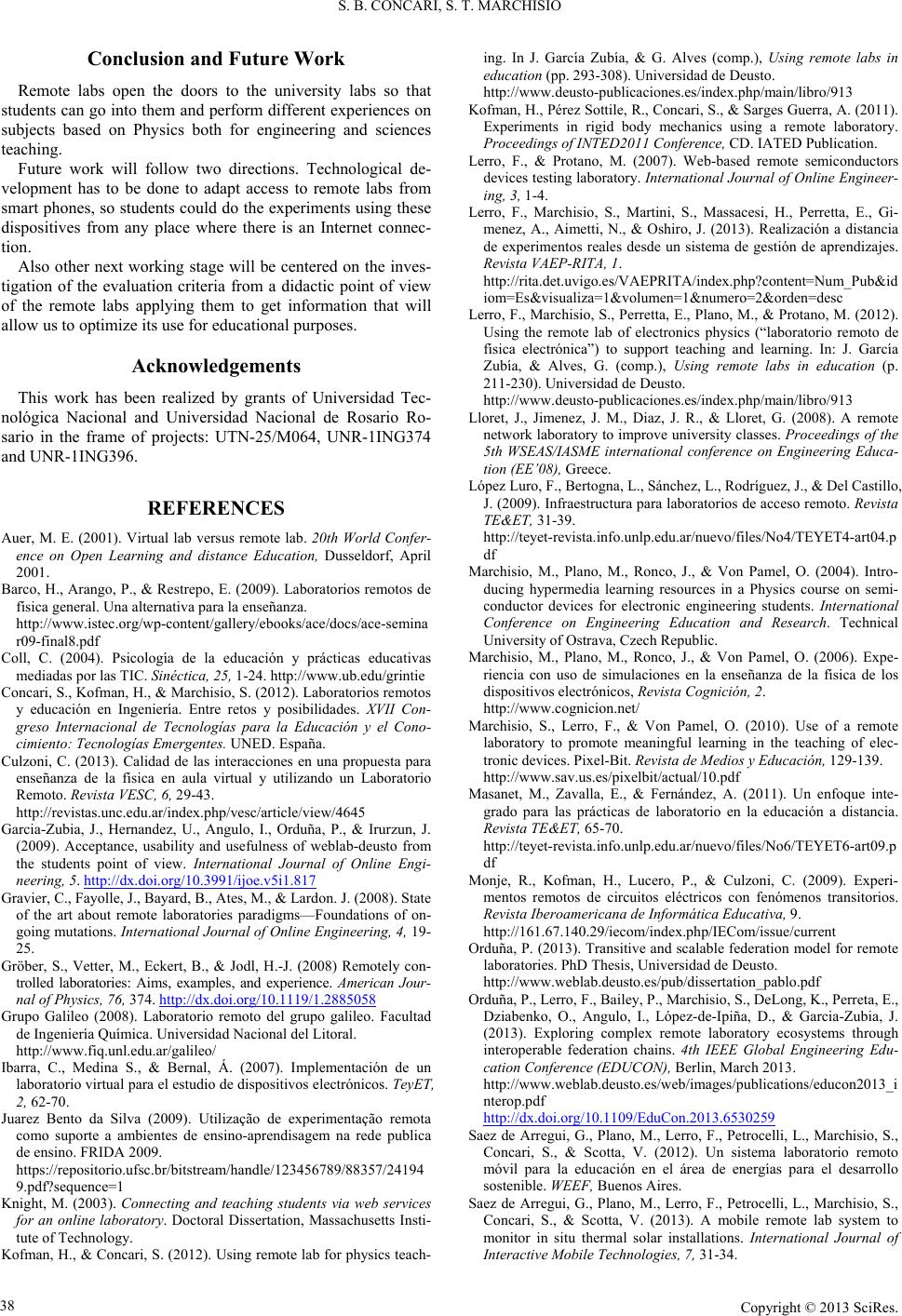
S. B. CONCARI, S. T. MARCHISIO
Conclusion and Future Work
Remote labs open the doors to the university labs so that
students can go into them and perform different experiences on
subjects based on Physics both for engineering and sciences
teaching.
Future work will follow two directions. Technological de-
velopment has to be done to adapt access to remote labs from
smart phones, so students could do the experiments using these
dispositives from any place where there is an Internet connec-
tion.
Also other next working stage will be centered on the inves-
tigation of the evaluation criteria from a didactic point of view
of the remote labs applying them to get information that will
allow us to optimize its use for educational purposes.
Acknowledgements
This work has been realized by grants of Universidad Tec-
nológica Nacional and Universidad Nacional de Rosario Ro-
sario in the frame of projects: UTN-25/M064, UNR-1ING374
and UNR-1ING396.
REFERENCES
Auer, M. E. (2001). Virtual lab versus remote lab. 20th World Confer-
ence on Open Learning and distance Education, Dusseldorf, April
2001.
Barco, H., Arango, P., & Restrepo, E. (2009). Laboratorios remotos de
física general. Una alternativa para la enseñanza.
http://www.istec.org/wp-content/gallery/ebooks/ace/docs/ace-semina
r09-final8.pdf
Coll, C. (2004). Psicología de la educación y prácticas educativas
mediadas por las TIC. S in é ct i c a, 25, 1-24. http://www.ub.edu/grintie
Concari, S., Kofman, H., & Marchisio, S. (2012). Laboratorios remotos
y educación en Ingeniería. Entre retos y posibilidades. XVII Con-
greso Internacional de Tecnologías para la Educación y el Cono-
cimiento: Tecnologías Emergentes. UNED. España.
Culzoni, C. (2013). Calidad de las interacciones en una propuesta para
enseñanza de la física en aula virtual y utilizando un Laboratorio
Remoto. Revista VESC, 6, 29-43.
http://revistas.unc.edu.ar/index.php/vesc/article/view/4645
Garcia-Zubia, J., Hernandez, U., Angulo, I., Orduña, P., & Irurzun, J.
(2009). Acceptance, usability and usefulness of weblab-deusto from
the students point of view. International Journal of Online Engi-
neering, 5. http://dx.doi.org/10.3991/ijoe.v5i1.817
Gravier, C., Fayolle , J., Bayard, B., Ates, M., & Lardon. J. (2 008). State
of the art about remote laboratories paradigms—Foundations of on-
going mutations. International Journal of Online Engineering, 4, 19-
25.
Gröber, S., Vetter, M., Eckert, B., & Jodl, H.-J. (2008) Remotely con-
trolled laboratories: Aims, examples, and experience. American Jour-
nal of Physics, 76, 374. http://dx.doi.org/10.1119/1.2885058
Grupo Galileo (2008). Laboratorio remoto del grupo galileo. Facultad
de Ingeniería Química. Universidad Nacional del Litoral.
http://www.fiq.unl.edu.ar/galileo/
Ibarra, C., Medina S., & Bernal, Á. (2007). Implementación de un
laboratorio virtual para el estudio de dispositivos electrónicos. TeyET,
2, 62-70.
Juarez Bento da Silva (2009). Utilização de experimentação remota
como suporte a ambientes de ensino-aprendisagem na rede publica
de ensino. FRIDA 2009.
https://repositorio.ufsc.br/bitstream/handle/123456789/88357/24194
9.pdf?sequence=1
Knight, M. (2003). Connecting and teaching students via web services
for an online laboratory. Doctoral Dissertation, Massachusetts Insti-
tute of Technology.
Kofman, H., & Concari, S. (2012). Using remote lab for physics teach-
ing. In J. García Zubía, & G. Alves (comp.), Using remote labs in
education (pp. 293- 30 8). Universidad de Deusto.
http://www.deusto-publicaciones.es/index.php/main/libro/913
Kofman, H., Pérez Sottile, R., Concari, S., & Sarges Guerra, A. (2011).
Experiments in rigid body mechanics using a remote laboratory.
Proceedings of INTED2011 Conference, C D. IATED Publication.
Lerro, F., & Protano, M. (2007). Web-based remote semiconductors
devices testing laboratory. International Journal of Online Engineer-
ing, 3, 1-4.
Lerro, F., Marchisio, S., Martini, S., Massacesi, H., Perretta, E., Gi-
menez, A., Aimetti, N., & Oshiro, J. (2013). Realización a distancia
de experimentos reales desde un sistema de gestión de aprendizajes.
Revista VAEP-RITA, 1.
http://rita.det.uvigo.es/VAEPRITA/index.php?content=Num_Pub&id
iom=Es&visualiza=1&volumen=1&numero=2&orden=desc
Lerro, F., Marchisio, S., Perretta, E., Plano, M., & Protano, M. (2012).
Using the remote lab of electronics physics (“laboratorio remoto de
física electrónica”) to support teaching and learning. In: J. García
Zubía, & Alves, G. (comp.), Using remote labs in education (p.
211-230). Univer sida d de Deu sto .
http://www.deusto-publicaciones.es/index.php/main/libro/913
Lloret, J., Jimenez, J. M., Diaz, J. R., & Lloret, G. (2008). A remote
network laboratory to improve university classes. Proceedings of the
5th WSEAS/IASME international conference on Engineering Educa-
tion (EE’08), Greece.
López Luro, F., Bertogna, L., Sánchez, L., Rodríguez, J., & Del Castillo,
J. (2009). Infraestructura para laboratorios de acceso remoto. Revista
TE&ET, 31-39.
http://teyet-revista.info.unlp.edu.ar/nuevo/files/No4/TEYET4-art04.p
df
Marchisio, M., Plano, M., Ronco, J., & Von Pamel, O. (2004). Intro-
ducing hypermedia learning resources in a Physics course on semi-
conductor devices for electronic engineering students. International
Conference on Engineering Education and Research. Technical
University of Ostrava, Czech Republic.
Marchisio, M., Plano, M., Ronco, J., & Von Pamel, O. (2006). Expe-
riencia con uso de simulaciones en la enseñanza de la física de los
dispositivos electrónicos, Revista Cogni c i ón , 2.
http://www.cognicion.net/
Marchisio, S., Lerro, F., & Von Pamel, O. (2010). Use of a remote
laboratory to promote meaningful learning in the teaching of elec-
tronic devices. Pixel-Bit. Revista de Medios y Educación, 129-139.
http://www.sav.us.es/pixelbit/actual/10.pdf
Masanet, M., Zavalla, E., & Fernández, A. (2011). Un enfoque inte-
grado para las prácticas de laboratorio en la educación a distancia.
Revista TE&ET, 65-70.
http://teyet-revista.info.unlp.edu.ar/nuevo/files/No6/TEYET6-art09.p
df
Monje, R., Kofman, H., Lucero, P., & Culzoni, C. (2009). Experi-
mentos remotos de circuitos eléctricos con fenómenos transitorios.
Revista Iberoamericana de Infor m á tica Educativa, 9.
http://161.67.140.29/iecom/index.php/IECom/issue/current
Orduña, P. (2013). Transitive and scalable federation model for remote
laboratories. PhD Thesis, Universidad de Deusto.
http://www.weblab.deusto.es/pub/dissertation_pablo.pdf
Orduña, P., Lerro, F., Bailey, P., Marchisio, S., DeLong, K., Perreta, E.,
Dziabenko, O., Angulo, I., López-de-Ipiña, D., & Garcia-Zubia, J.
(2013). Exploring complex remote laboratory ecosystems through
interoperable federation chains. 4th IEEE Global Engineering Edu-
cation Conference (EDUCON), Berlin, March 2013.
http://www.weblab.deusto.es/web/images/publications/educon2013_i
nterop.pdf
http://dx.doi.org/10.1109/EduCon.2013.6530259
Saez de Arregui, G., Plano, M., Lerro, F., Petrocelli, L., Marchisio, S.,
Concari, S., & Scotta, V. (2012). Un sistema laboratorio remoto
móvil para la educación en el área de energías para el desarrollo
sostenible. WEEF, Buenos Aires.
Saez de Arregui, G., Plano, M., Lerro, F., Petrocelli, L., Marchisio, S.,
Concari, S., & Scotta, V. (2013). A mobile remote lab system to
monitor in situ thermal solar installations. International Journal of
Interactive Mobile Technolog ies, 7, 31-34.
Copyright © 2013 SciRes.
38